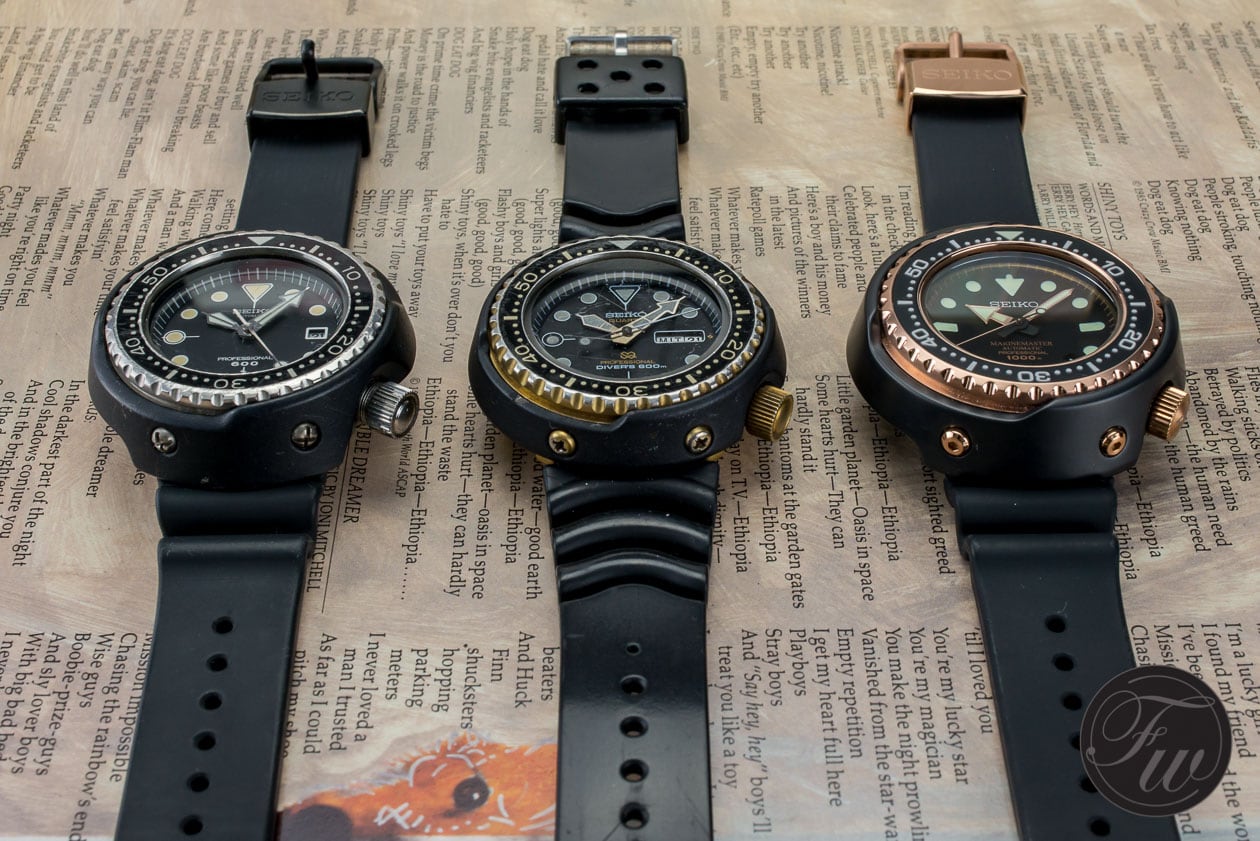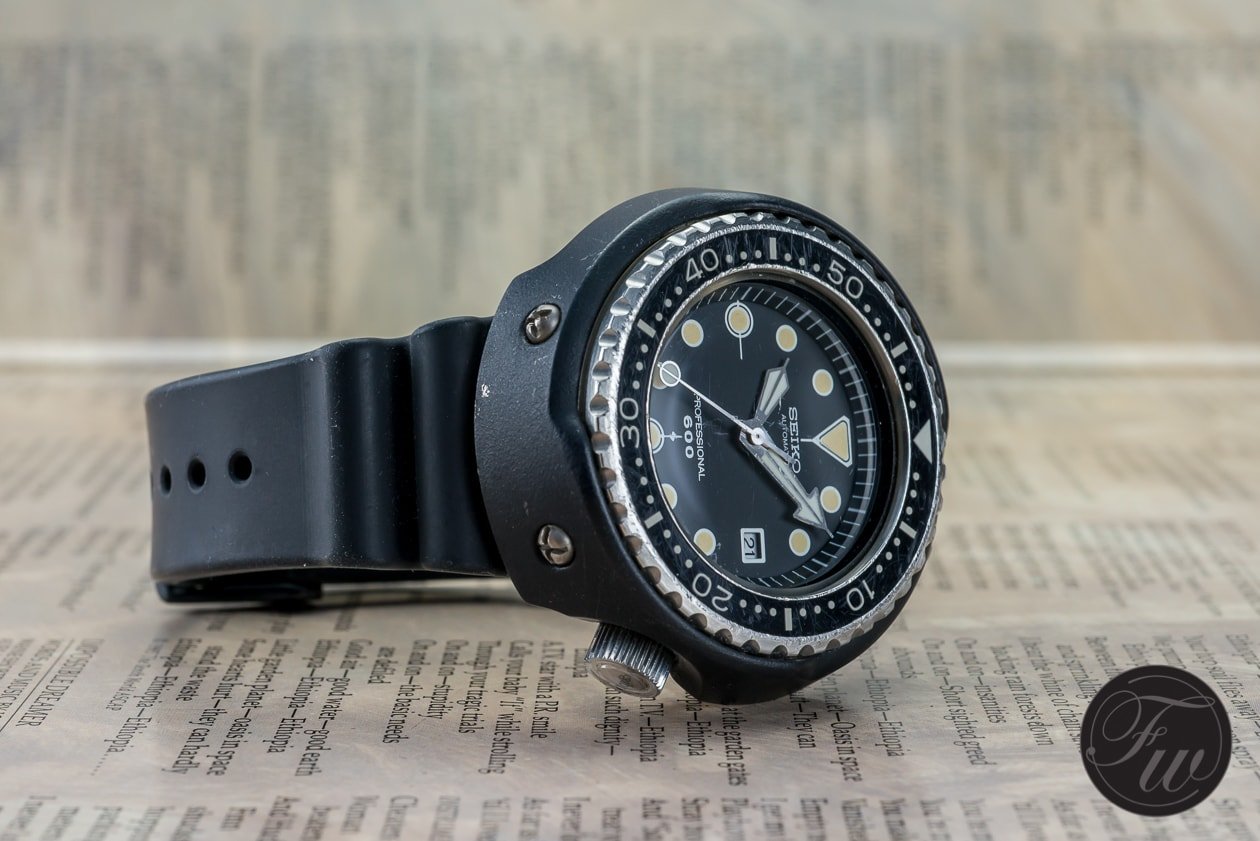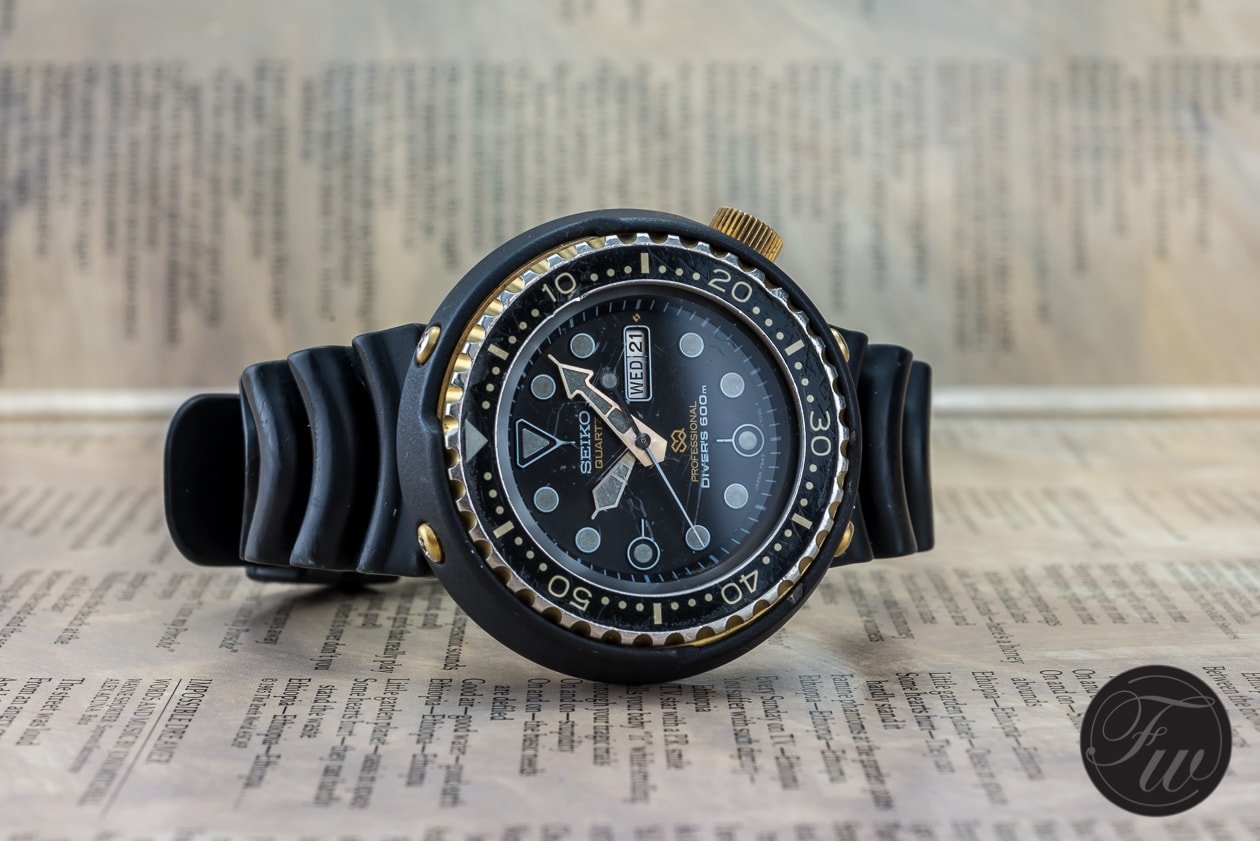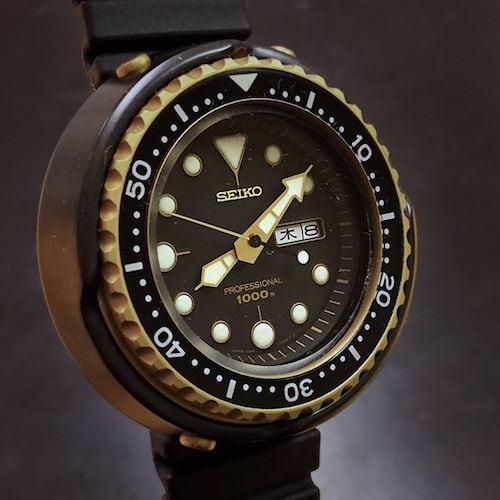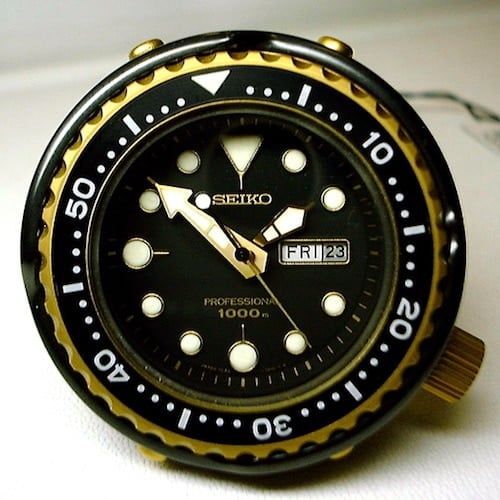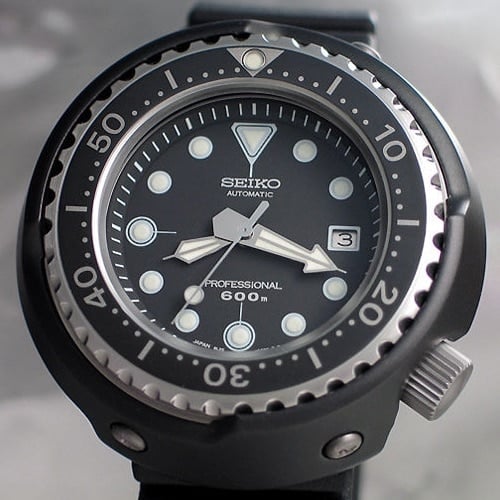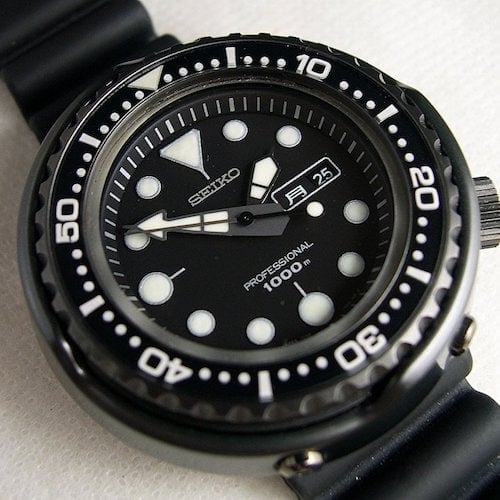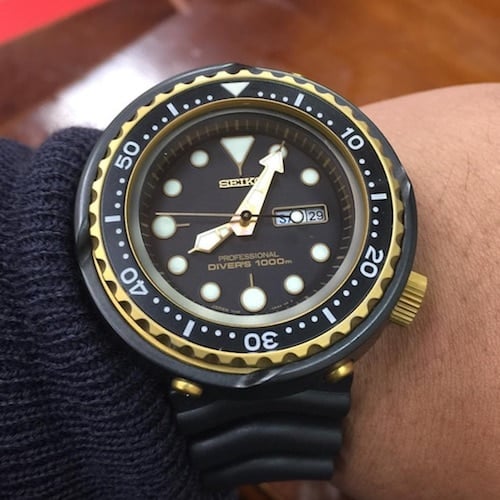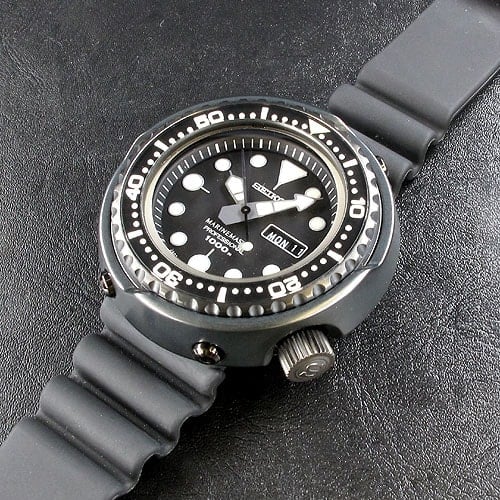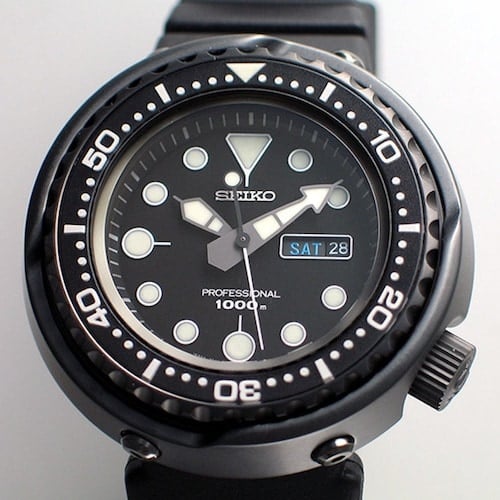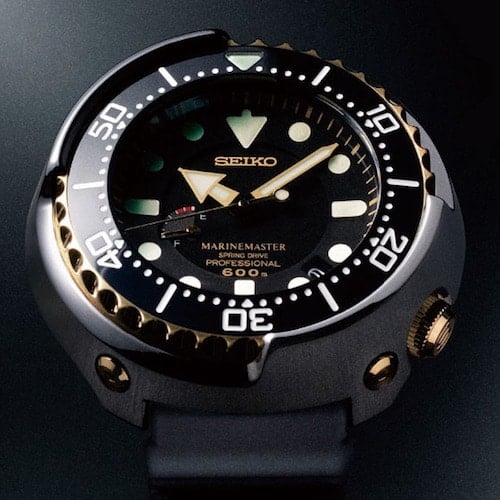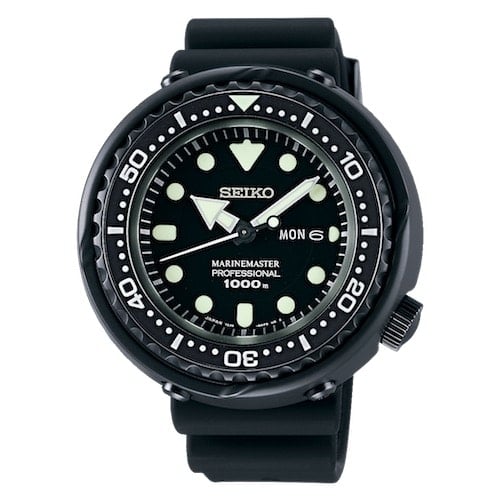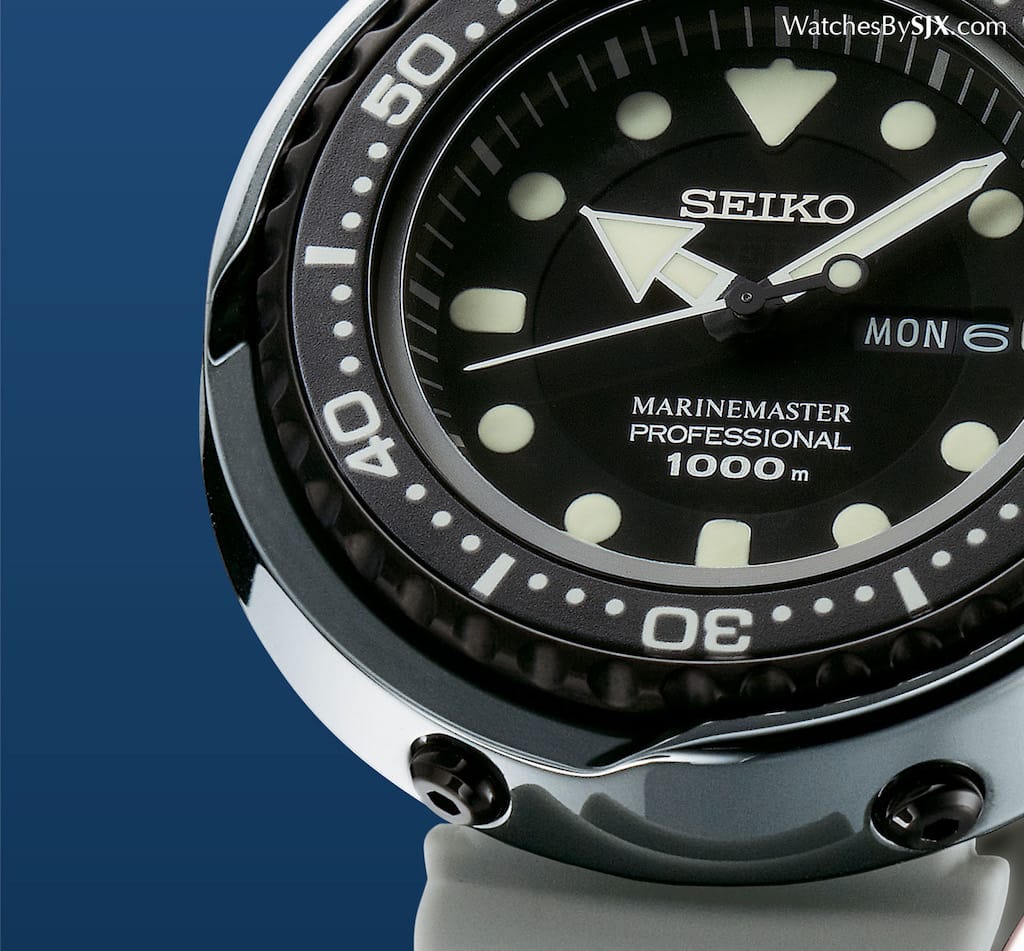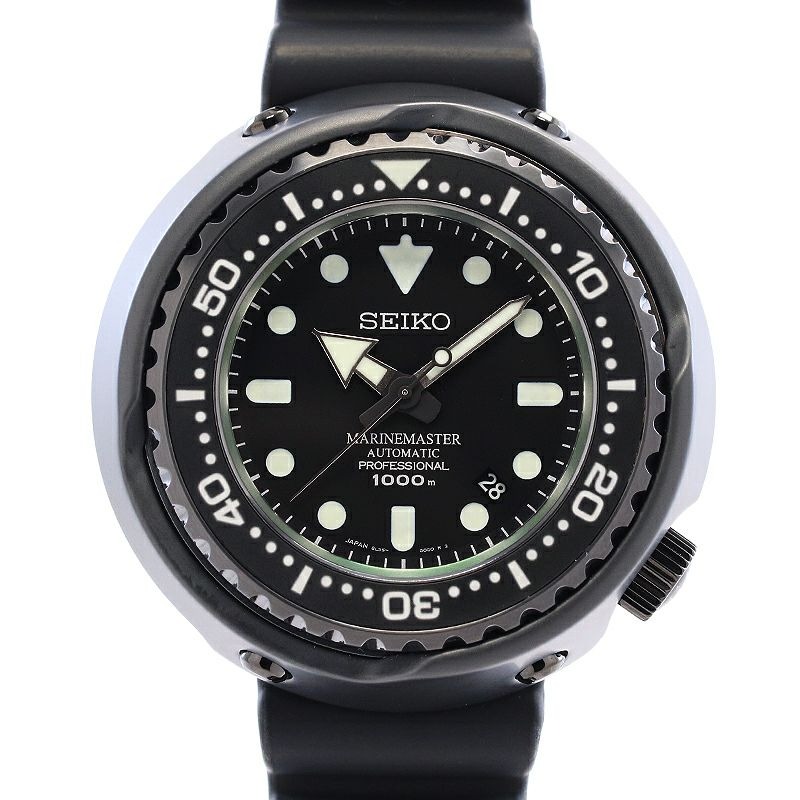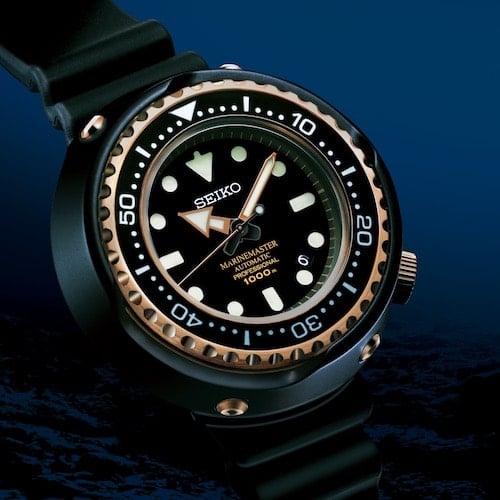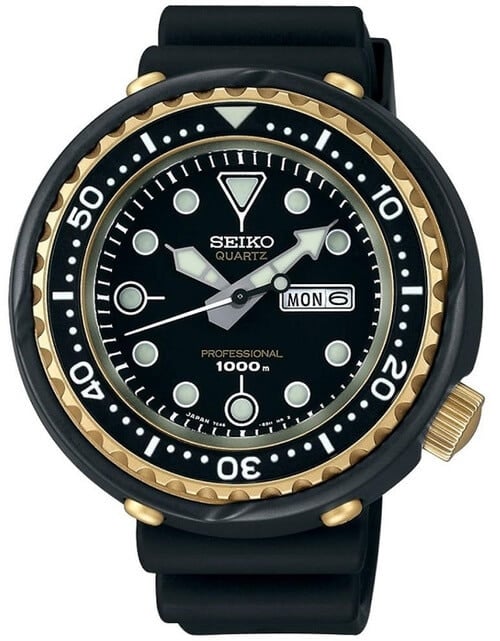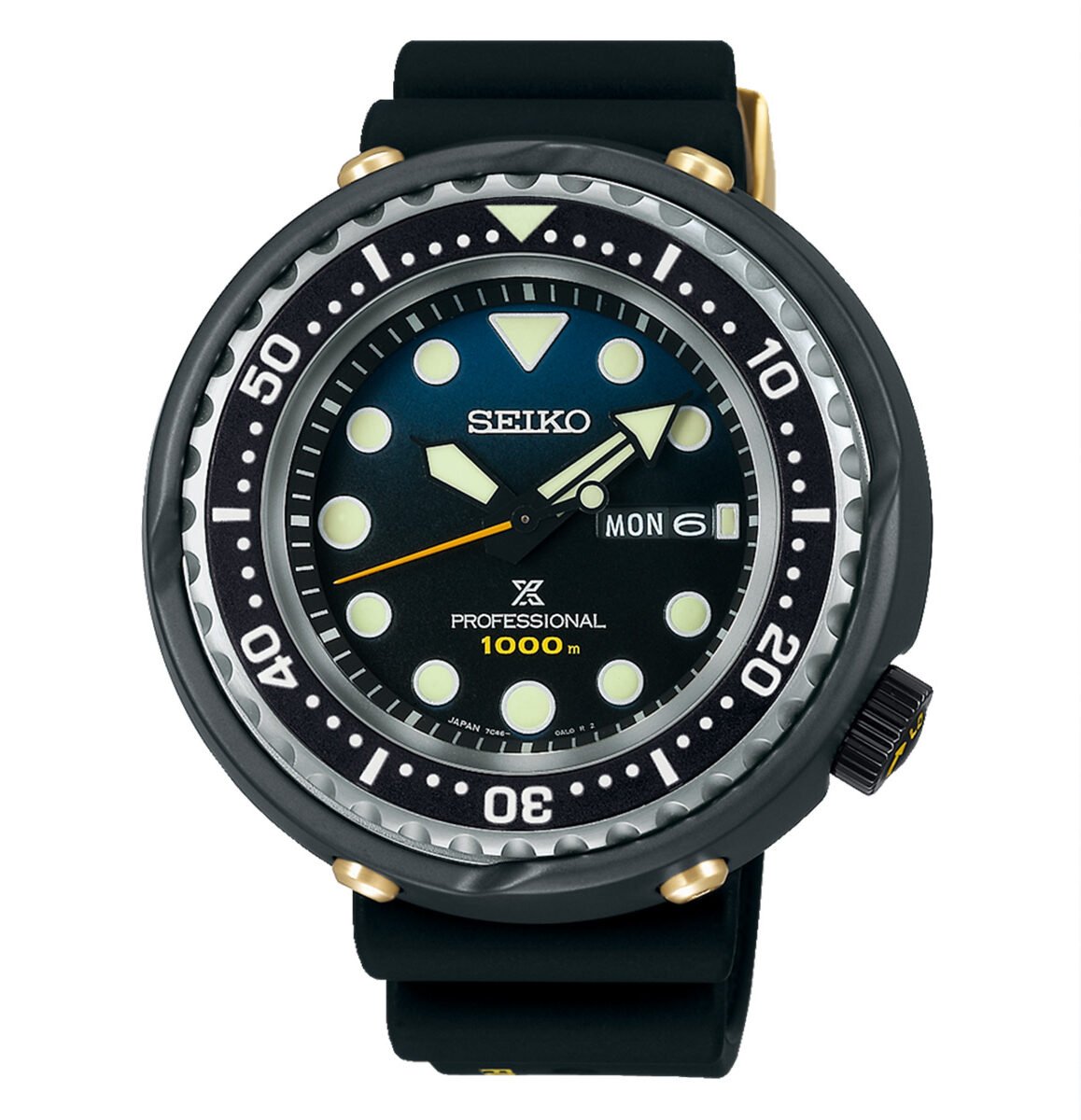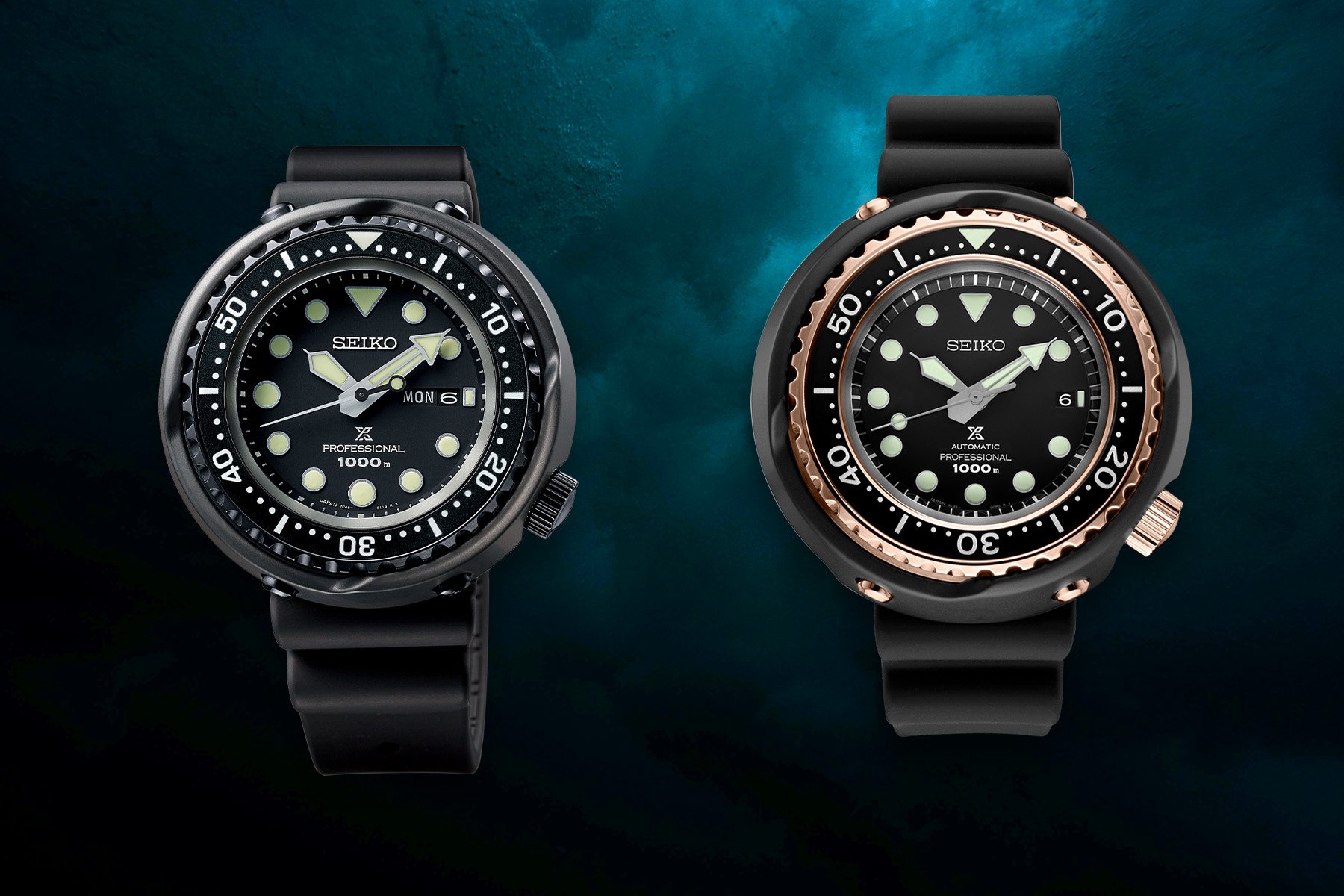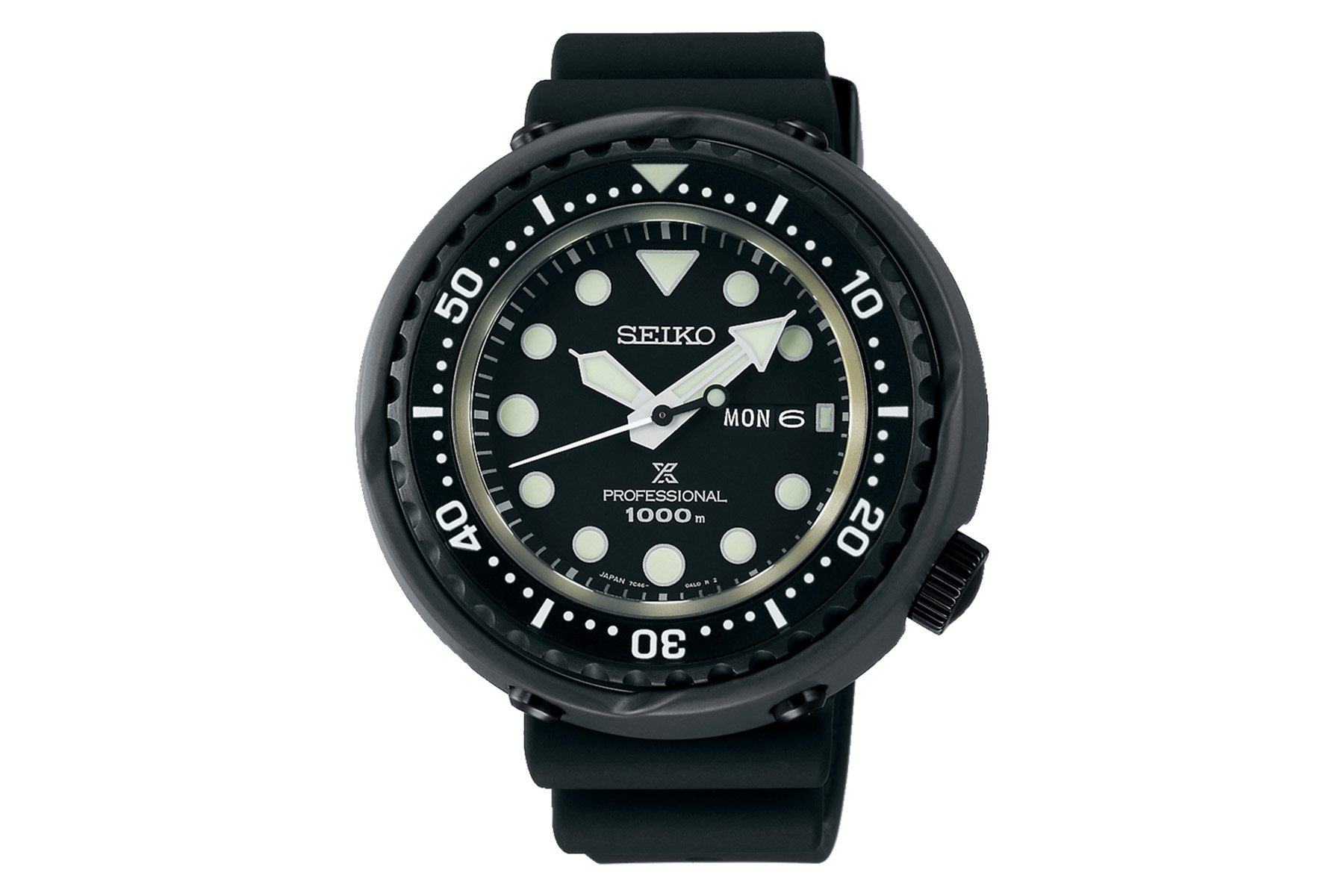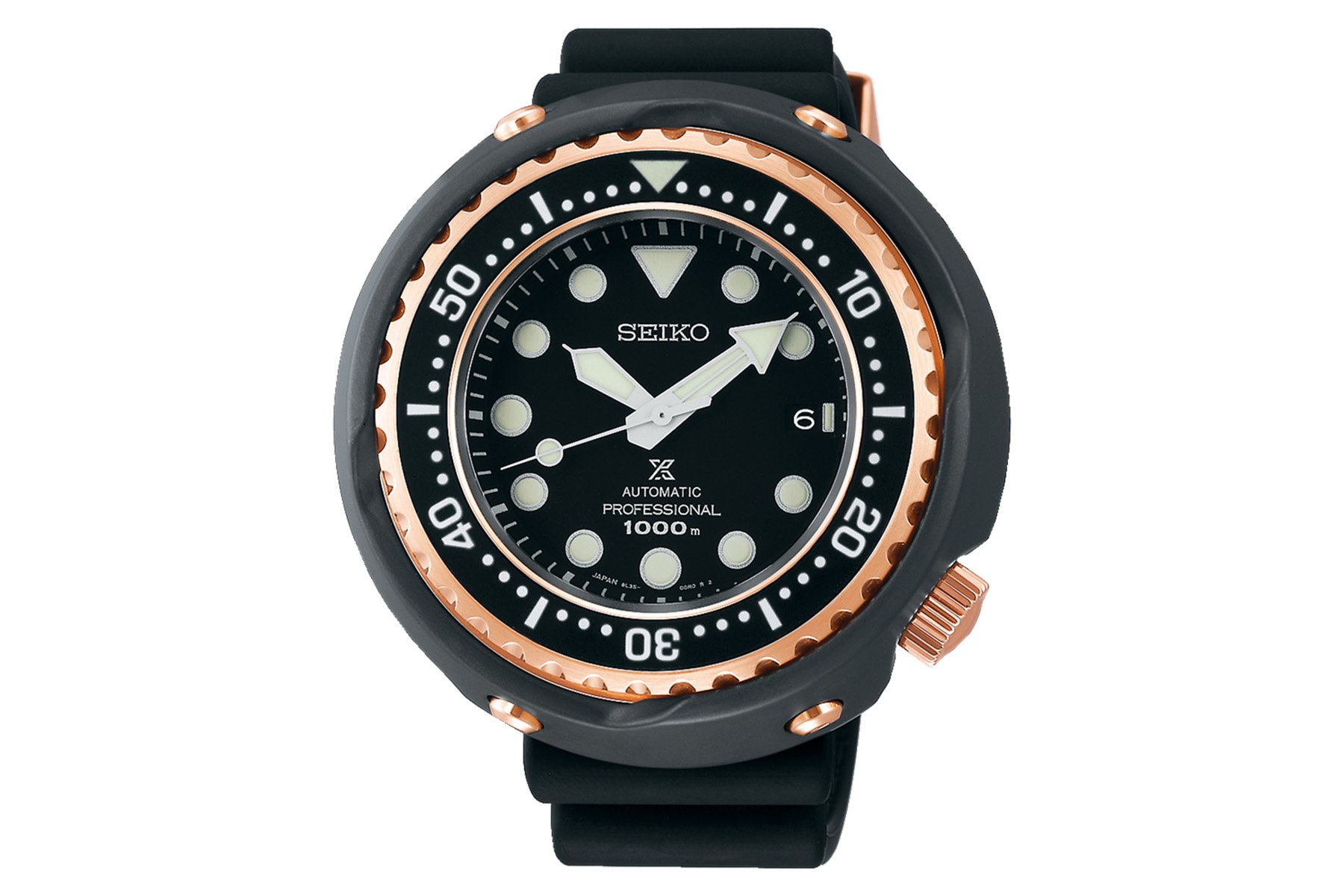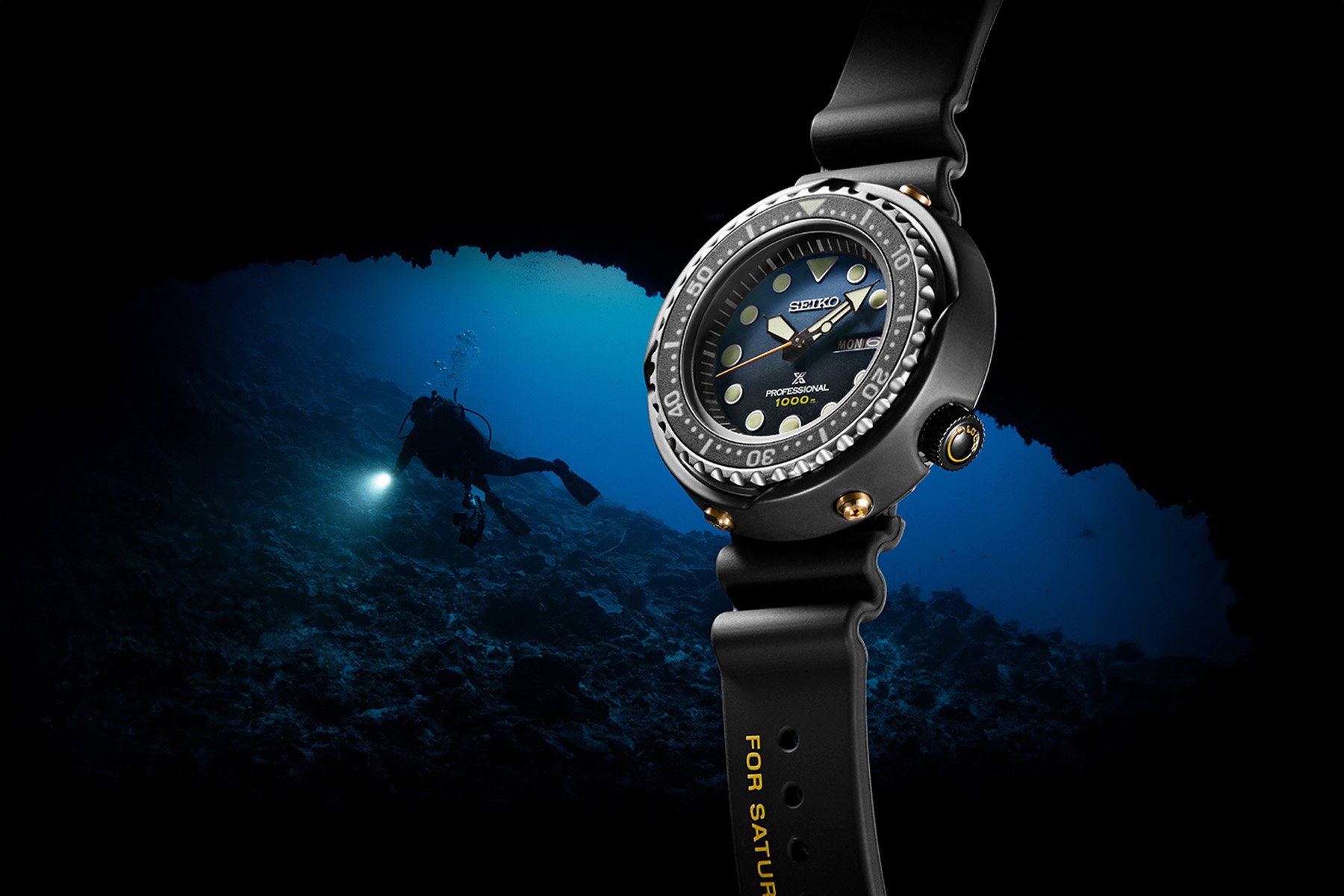The Monocoque Seiko Tuna Models — A History And Overview
The Seiko Tuna is sacred ground to geeks and a rathole to others. This article, however, is for everyone. The hope is to provide insight into the history of all monocoque Seiko Tuna models, starting with the 1975 reference 6159-7010 and finishing with the SBDX038 and SBBN047 of today.
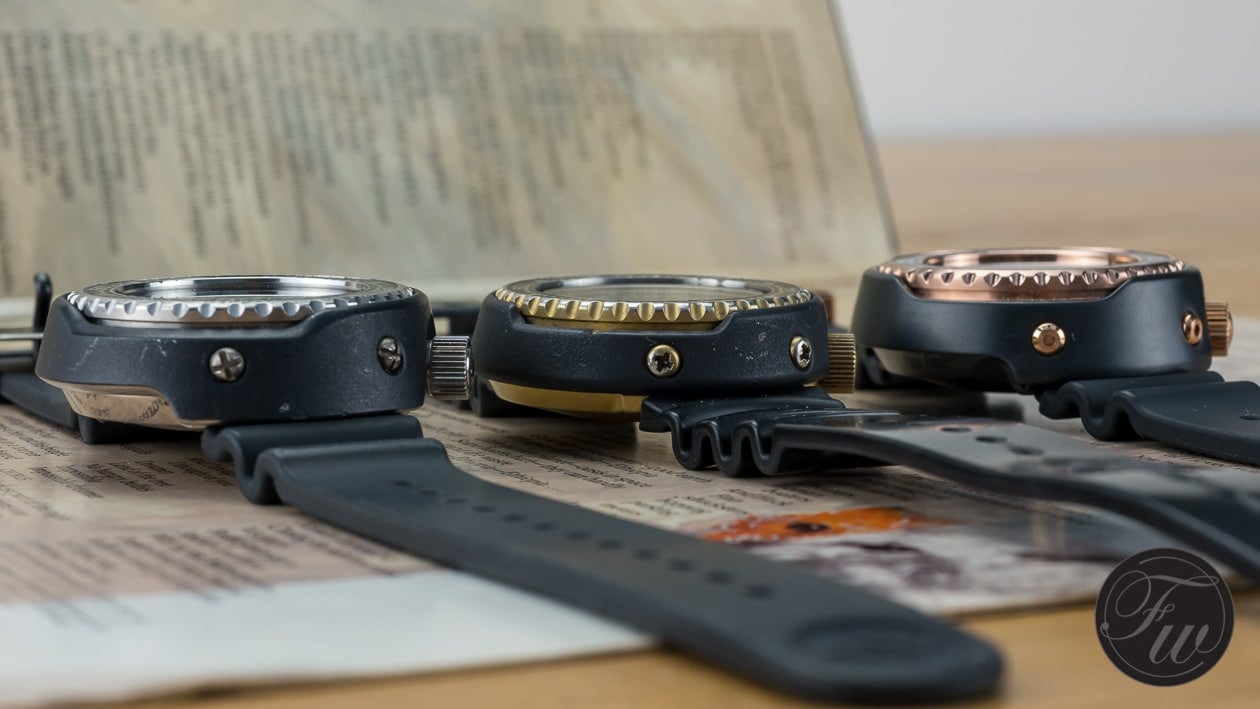
You’ve probably all heard of the Seiko “Tuna” professional diving watches. And you might also know that this wasn’t the name Seiko gave the watch at its “birth.” Because of the cylindrical shape of the lugless watch case, its form resembled a tuna can. Some say the Tuna nickname came up years ago on one of the internet watch forums. I guess it’s clear that it has little to do with the fish species but more with the tin where tuna often ends up.
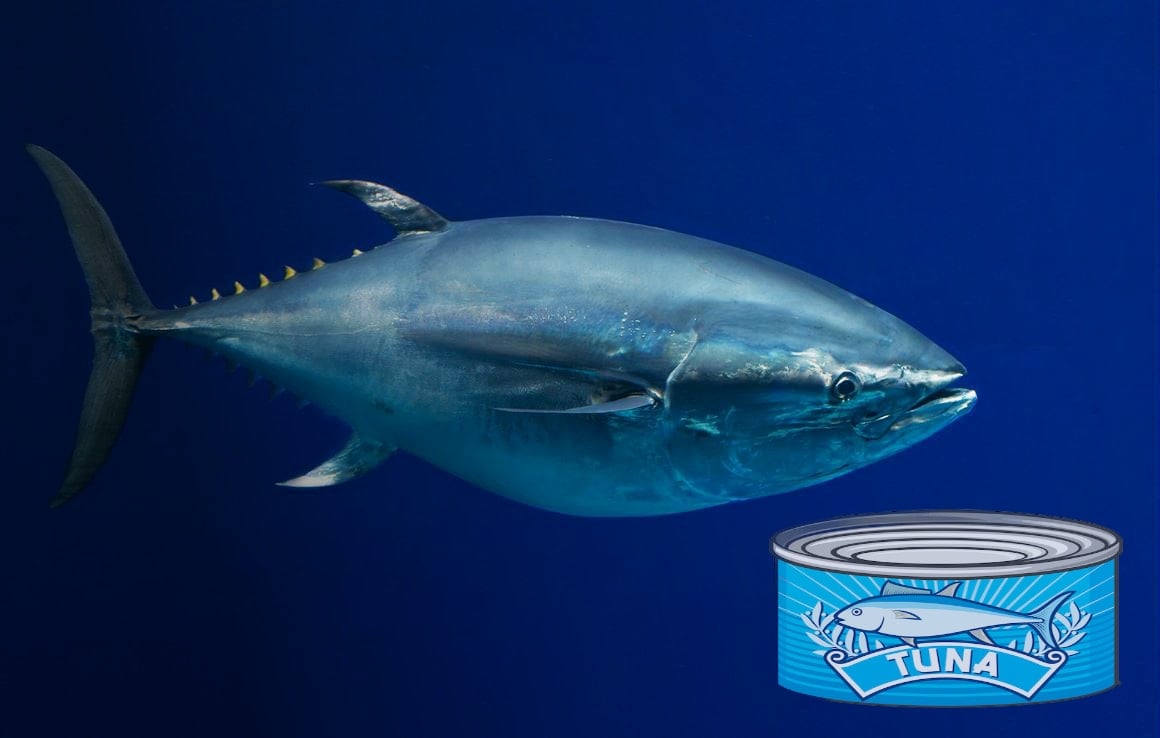
Meanwhile, the Tuna nickname encompasses a universe of different Seiko dive watches. It’s certainly not one watch we’re looking at here. Rather, it is much more of a series. Seiko Tuna is not an official model name, and this is where the fog kicks in, where we no longer see the woods for the trees.
A bit of Seiko Tuna history
Where to start? Let’s just briefly mention that Seiko has produced watches for divers since 1965. Model 6217-8001, also known as the 62MAS, debuted with a 150m depth rating and a rotating divers bezel as Seiko’s first divers watch. You’ll find Michael Stockton’s article on that watch here. In 1967/8, two updated versions, models 6215-010 and 6159-010, could withstand a 300m water column.
However, just like other manufacturers, Seiko faced trouble when these watches were used professionally for helium saturation diving at great depths. Dive watches blew their crystals off during decompression. It became evident that the inert helium gas used under high pressures could enter a watch through regular gasket constructions. The building pressure inside the watch was equal to the pressure outside at that depth. Then, during the diver’s decompression, the helium gas couldn’t get out quickly enough, and the pressure inside the watch would cause the crystal to blow off.
The Seiko solution
At that time, some manufacturers looked for a way to remove the pressurized helium from the watch during decompression. Seiko, however, went a different route. Under the patronage of Ikuo Tokunaga, Seiko chose to look for a solution so that the helium couldn’t enter the watch and no pressure would build up inside. This solution came in the form of a unique type and construction of gasket combined with a titanium monocoque case. In 1975, Seiko used this for the first time in the 6159-7010, or model YAQ028.
Mr. Ikuo Tokunaga explained Seiko Professional divers watches during the 2015 Seiko Media Experience Tour (click here for the full report). He also mentioned the book (in Japanese language only) that he wrote about them.
The Seiko 6159-7010 was a watch with a lot of firsts. It was Seiko’s first watch with a “professional” 600m depth rating. It was also the world’s first diver’s watch with a monocoque titanium case. Furthermore, it was the first watch to feature a two-layer case construction with a titanium shroud coated with ceramic for greater shock protection. The watch came with a new accordion-style strap, ensuring ease of use by expanding and contracting as the wearer’s depth changed. All in all, this revolutionary timepiece boasted more than 20 patents.
The “Grandfather Tuna” 6159-7010
As mentioned above, the cylindrical shape of the 6159-7010’s lugless case resembled a tuna can. The officially named Professional Diver 600 would become the “Grandfather Tuna.” It’s a watch that all of us at Fratello greatly respect. Robert-Jan described the acquisition of his Seiko 6159-7010 here.
Now we’re getting to the point. This article aims to provide a starting point — 1975, the very first Seiko Tuna, implying that there were more to come. And that was what happened. To determine our starting point more precisely, I want to specify the main components and specifications of this first Seiko Tuna.
- Reference 6159-7010, model YAQ028, nickname Grandfather Tuna
- Large monocoque inner case made of titanium, steel bezel
- 51mm cylindrical protective black ceramic-coated titanium shroud bolted to the inner case
- Hardlex crystal
- Automatic Seiko 6159 movement, hi-beat (36,000vph) frequency, 25 jewels
- 600m depth rating
- Polyurethane strap
Important information if you intend to read on
From here, I won’t go into more or less equal-looking Seiko dive watches presented after the Grandfather Tuna but with lesser specifications. Understandably, they might also carry the Tuna nickname, but that’s because these watches look equal. Technically, they’re not. They don’t use a titanium monocoque case and are not at least 600m waterproof. I consider them commercial offspring, which I don’t include in this write-up. This article is about the real-deal Seiko Tuna without any distractions.
The first descendant, the “Golden Tuna” 7549-7009
Let’s transport ourselves to the end of the 1970s. Mechanical automatic watch movements were having a hard time, and new quartz technology providing much higher accuracy was knocking on the door. Switzerland was sleeping, and this new technology came from Japan. Unsurprisingly, in 1978, only three years after the Grandfather Tuna’s debut, Seiko’s upgrade to its most professional watch was a five-jewel quartz movement. The caliber number of this quartz movement was 7549, so the first descendant of the Grandfather Tuna became the 7549-7009, or model PYF018.
Something else changed as well, though. The watch’s titanium inner case received a titanium nitride coating to enhance its surface properties. Titanium nitride (TiN) is a rigid ceramic material with a golden appearance. Aside from the color difference, the size also changed; it became approximately 2mm smaller. The “Golden Tuna” was the next family member, which brings us to the following specifications:
- Reference 7549-7009, model PYF018, nickname Golden Tuna
- Large monocoque inner case made of TiN-coated titanium, gold-colored steel bezel
- 49mm cylindrical protective black ceramic-coated titanium shroud bolted to the inner case
- Hardlex crystal
- Seiko 7549 quartz movement, five jewels
- 600m pressure rating
- Polyurethane strap
The actual offspring, the SSBS018
As mentioned, I won’t include all kinds of similar-looking models with lesser specifications in this article. Therefore, it took eight years before a genuine successor arrived. Seiko raised the titanium monocoque Professional Quartz Diver’s pressure rating even further to a whopping 1,000 meters. The watch also contained a revamped and much-improved quartz movement. The new caliber was the seven-jewel 7C46, which made the watch the 7C46-7009, or model SSBS018. In some documents, the watch is mentioned as model SBDS018, but this designation is not confirmed. Because the watch’s looks didn’t change much, the nickname remained Golden Tuna. An important technical update was using solid ceramic as a material for the shroud instead of ceramic-coated titanium. The inner case remained titanium with a TiN coating but paired with a black ceramic titanium shroud. It’s 1986, and we’re up to the following specifications:
- Reference 7C46-7009, model SSBS018, nickname Golden Tuna
- Large monocoque inner case made of TiN-coated titanium, gold-colored steel bezel
- 49mm cylindrical protective black ceramic titanium shroud bolted to the inner case
- Hardlex crystal
- High-quality Seiko 7C46 quartz movement, seven jewels
- 1,000m pressure rating
- Polyurethane strap
After the SSBS018, Seiko remained relatively quiet regarding the development of monocoque Tuna for more than a decade. Of course, some lesser brothers were born while Seiko tried implementing new techniques in Tuna-like watches. An AGS (later named Kinetic) movement saw the light in 1990, domed glass was implemented on a 300m-rated model, and a ScubaPro-branded version debuted in 1999.
And then a Golden Tuna reissue, the new SSBS018
Then, in 1999, Seiko reissued the 1,000m-rated Golden Tuna. It was the reference 7C46-7008, again with model indication SSBS018. I consider a “reissue” to mean a new version of a watch that looks more or less the same. The aesthetic differences between the new SSBS018 and the prior one were in the dial, the strap, and the lettering on the case back. All was visually hardly noticeable, though, so it remained more or less the same watch. Here are its specifications:
- Reference 7C46-7008, model SSBS018, nickname Golden Tuna
- Large monocoque inner case made of TiN-coated titanium, gold-colored steel bezel
- 49mm cylindrical protective black ceramic shroud bolted to the inner case
- Hardlex crystal
- High-quality Seiko 7C46 quartz movement, seven jewels
- 1,000m pressure rating
- Polyurethane strap
A limited-edition homage, the SBDX005
One year later, in 2000, there was great news. In the Seiko Historical Collection Year 2000, the brand presented a homage to the original Grandfather Tuna. In my opinion, it was a relatively well-done edition. Like the original 6159-7010, it had a slightly larger 51mm diameter versus the 49mm diameter of later quartz descendants. Seiko used an automatic movement again as well. This time, it was the 8L35, a high-quality automatic caliber derived from Grand Seiko’s 9S55 but lacking its decoration and fine adjustment. Even the quartz descendants’ golden/black touches were omitted; the homage had an uncoated titanium monocoque inner case again and a black ceramic-coated titanium shroud.
The reference number of this homage was 8L35-0030, and the model indication was SBDX005. The sad thing was that Seiko only produced 1,000 pieces of this watch. Here’s the list of specifications:
- Reference 8L35-0030, model SBDX005, nickname Historical Tuna, 1,000 numbered pieces
- Large monocoque inner case made of titanium, steel bezel
- 51mm cylindrical protective black ceramic-coated titanium shroud bolted to the inner casing
- Hardlex crystal
- Automatic Seiko 8L35 movement, 28,800vph frequency, 26 jewels
- 600m pressure rating
- Polyurethane strap
The all-black “Darth Tuna” SBBN011
Five years later, in 2005, Seiko changed the Tuna and updated it slightly. A black PVD-coated titanium inner case replaced the gold-colored TiN-treated one. Furthermore, the gold PVD stainless steel bezel went black as well. And the gold-colored Phillips-head screws fixing the ceramic shroud to the inner case changed to black hex bolts. Finally, Seiko opted for a sapphire crystal instead of its homegrown Hardlex for the first time.
This watch’s all-black appearance inspired the “Darth Tuna” nickname. And I guess because of the all-black cylindrical appearance, this watch also might have been the first one referred to as “Hockey Puck.” The official Seiko reference for this watch is 7C46-0AA0, or model SBBN011. Here are the specs to compare:
- Reference 7C46-0AA0, model SBBN011, nickname Darth Tuna
- Large monocoque inner case made of PVD-coated titanium, black PVD-coated steel bezel
- 49mm cylindrical protective black ceramic shroud bolted to the inner case
- Flat sapphire crystal with AR coating inside
- High-quality Seiko 7C46 quartz movement, seven jewels
- 1,000m pressure rating
- Polyurethane strap
A model we don’t know much about, the S23611J1
It must have been after 2006 that a rather interesting but relatively mysterious TiN-coated Golden Tuna surfaced. Its reference was 7C46-0AB0, and it had model indication S23611J1. It happened to be very similar to the 7C46-7008/SSBS018 from 1999. Some believe this model was specifically for exclusive sales in Taiwan, but this has yet to be confirmed. The specifications are the same as the last Golden Tuna re-edition. The dial seems different, though, and as mentioned on the case back, it sports a flat sapphire crystal.
- Reference 7C46-0AB0, model S23611J1, nickname Golden Tuna
- Large monocoque inner case made of TiN-coated titanium, gold-colored steel bezel
- 49mm cylindrical protective black ceramic-coated titanium shroud bolted to the inner case
- Flat sapphire crystal with AR coating inside
- High-quality Seiko 7C46 quartz movement, seven jewels
- 1,000m pressure rating
- Polyurethane strap
Speeding up to the SBBN013
In 2009, Seiko presented two new Tunas at once. After only four years, the SBBN011 Darth Tuna made way for the SBBN013, which was technically the same watch. Even the 7C46-0AA0 reference number and its Darth Tuna nickname didn’t change. The only changes were the dial and the crown. The dial of the SBBN013 was marked “Marinemaster,” and the crown was signed with an S, which wasn’t the case with the SBBN011. Otherwise, the two watches were the same. The SBBN013 kept the flat sapphire crystal and a ceramic shroud. While there’s no big news here, I’ll list the specs to be complete:
- Reference 7C46-0AA0, model SBBN013, nickname Darth Tuna
- Large monocoque inner case made of PVD-coated titanium, black PVD-coated steel bezel
- 49mm cylindrical protective black ceramic shroud bolted to the inner case
- Flat sapphire crystal with AR coating inside
- High-quality Seiko 7C46 quartz movement, seven jewels
- 1,000m pressure rating
- Polyurethane strap
And the automatic SBDX011
The second new Seiko Tuna introduced in 2009 was the 8L35-00C0, or model SBDX011. This was the 8L35-0030 Historical Tuna but mainly aesthetically altered and brought out again. The Historical Tuna’s bare titanium case received a black PVD coating, which led to the nickname “Emperor Tuna.” As a technical update, it received a sapphire crystal instead of a Hardlex one. Like the SBBD013, with its relatively equal all-black look, the 8L35-00C0 had “Marinemaster” printed on the dial. Mike Stockton wrote a nice comparative article on the Emperor Tuna here. Please find the watch’s specifications below:
- Reference 8L35-00C0, model SBDX011, nickname Emperor Tuna
- Large monocoque inner case made of PVD-coated titanium, black PVD-coated steel bezel
- 51mm cylindrical protective black ceramic-coated titanium shroud bolted to the inner case
- Flat sapphire crystal with AR coating inside
- Automatic Seiko 8L35 movement, 28,800vph frequency, 26 jewels
- 1,000m pressure rating
- Polyurethane strap
Taiwan
In addition to the rumors about the second re-edition of the Golden Tuna (7C46-0AB0) in 2006, it seems that in 2011, Seiko released a black PVD-coated reference 7C46-0AA0 Darth Tuna (model S23619J1) specifically for Taiwan as well. The reference for the watch (7C46-0AA0) was the same as the SBBN011 and SBBN013; technically, the watch was much like it. The only difference could be the battery-change date printing on the case back. As seen below, it had a signed crown like the SBBN013. But while the SBBN013 had “Marinemaster” printed on the dial, the S23619J1 didn’t, just like the SBBN011. I won’t mention specs here, as they are equal to the Darth Tunas mentioned before.
The 100th anniversary of Seiko watchmaking
Although the Seiko company had been registered a few years longer, 2013 marked the 100th anniversary of Seiko watchmaking. To celebrate this anniversary, among other special watches, Seiko introduced a Spring Drive-powered Tuna, reference 5R65-0AJ0, or model SBDB008. With its golden accents and 600m depth rating, the watch was similar to the first Golden Tuna. Therefore, it is often called Golden Spring Drive Tuna.
However, I promised not to list Seiko Tuna models that don’t comply with the design rules and specifications of the original Seiko Tuna concept. And the Golden Spring Drive Tuna doesn’t. Although its case is made of titanium, it is not of monocoque construction. It has a screw case back. Besides that, or probably even because of it, the watch has a domed sapphire crystal instead of a flat one, ruining the resemblance to a tuna can.
The 5R65-0AJ0 Golden Spring Drive Tuna was produced in a limited edition of only 300 pieces and aimed mainly at the Japanese market. One year later, in 2014, the same model but in all black without gold accents came as model SBDB009, later updated to SBDB013, available to the rest of the world.
The next quartz Tuna models
Around 2015, Seiko continued introducing a few quartz Tuna models. Reference 7C46-0AH0, or model SBBN025, was the second modern interpretation of the 1989 SBBN011 Darth Tuna. It had the same quartz movement and dimensions, a black PVD-coated monocoque case, and the same size. The nickname could’ve remained too, but it’s now sometimes called the “New Darth Tuna.” The hands changed quite a bit, though. Most eye-catching were the new arrow-shaped hour hand and the straight minute hand. We see similar handsets on many other Seiko Marinemaster and Prospex dive watches. While this wasn’t the first time Seiko changed the real-deal Tuna’s hands, previous alterations were never that radical. At this time, Seiko also changed from polyurethane straps to soft silicone straps, which was a welcome upgrade. Here are the specs of the watch:
- Reference 7C46-0AA0, model SBBN025, nickname New Darth Tuna
- Large monocoque inner case made of PVD-coated titanium, black PVD-coated steel bezel
- 49mm cylindrical protective black ceramic shroud bolted to the inner case
- Flat sapphire crystal with AR coating inside
- High-quality Seiko 7C46 quartz movement, seven jewels
- 1,000m pressure rating
- Silicone strap
SBBN02x variations
In the SBBN02x series, Seiko presented different Tuna models. The SBBN027 model, for example, is technically exactly equal to SBBN025. The only difference is aesthetics. The bezel insert, the “1000m” text, and the minute hand are yellow instead of black and white. Overall, the appearance of these quartz Seiko Tunas is quite different from that of the SBBN025 model. Technically, however, they’re not too far apart. The SBBN029 was also a technically equal model and a 700-piece limited edition. Here are the general specifications for these SBBN02x models:
- Reference 7C46-0A(x)0, model SBBN02x
- Large monocoque inner case, made of PVD-coated titanium, black PVD-coated steel bezel with different inlay colors
- 49mm cylindrical protective ceramic or cermet shroud bolted to the inner casing
- Flat sapphire crystal with AR coating inside
- High-quality Seiko 7C46 quartz movement, seven jewels
- 1,000m pressure rating
- Silicone strap
On with automatics, starting with the SBDX013
It is still 2015, and compared to its Emperor Tuna ancestor, the new automatic Seiko Tuna SBDX013 aesthetically changed even more than its quartz-powered brother. Except for the hands, also the dial changed drastically. The date window no longer resides at 3 o’clock but between 4 and 5. A first in 40 years. For the rest here as well, the technical details didn’t change much. It has the same automatic 8L35 movement, exact case dimensions, black PVD-coated monocoque case, and size.
- Reference 8L35-00H0, model SBDX013, nickname New Emperor Tuna
- Large monocoque inner case made of PVD-coated titanium, black PVD-coated steel bezel
- 51mm cylindrical protective black ceramic shroud bolted to the inner casing
- Flat sapphire crystal with AR coating inside
- Automatic Seiko 8L35 movement, 28,800vph frequency, 26 jewels
- 1,000m pressure rating
- Silicone strap
A new design feature
In the same year as the SBDX013 came out, the SBDX014 was revealed. Technically, both models are equal, but the SBDX014 has a new design feature. Though probably not noticeable at first glance, this is the first Seiko Tuna in which the bezel color differs from the watch’s case. Like the SBDX013, the SBDX014 has a black PVD-coated titanium monocoque case. However, while the former’s bezel also has a black PVD coating, with the SBDX014, the bezel is a rose gold color. It is quite different, however, it immediately resembles the former Golden Tuna.
- Reference 8L35-00H0, model SBDX014, nickname New Golden Tuna
- Large monocoque inner casing, made of DLC coated titanium, steel bezel rose gold colored.
- 51mm cylindrical protective black ceramic shroud bolted to the inner casing
- Flat sapphire crystal, ar-coated inside
- Automatic Seiko 8L35 movement, 28,800vph frequency, 26 jewels
- 1,000m pressure rating
- Silicone strap
The 40th anniversary of Golden Tuna
In 2018, Seiko celebrated the 40th anniversary of the first Golden Tuna. For this occasion, the brand presented the SBBN040 as a limited edition of 1,978 pieces. A lot went well. It had the beloved and cheered 7C46 quartz caliber. It even had an old-style handset. The original encircled indexes were back, and there was no modern “Marinemaster” designation on the dial or Prospex logo on the crown. We don’t care too much about the original Phillips screws on the shroud being replaced with today’s hex bolts. But what bothers me is the depth rating of the commemorative edition. That should have been 600m, just like the original Golden Tuna of 1978. Unfortunately, though, Seiko chose a 1,000m rating. This is the correct rating for this watch; however, it is inadequate as the designation for the 40th-anniversary limited edition. Bluntly, now it’s a re-edition of the 1986 1,000m-rated SBDS018.
- Reference 7C46-0AL0, model SBBN040
- Large monocoque inner case made of PVC-coated titanium, gold-colored steel bezel
- 49mm cylindrical protective black ceramic shroud bolted to the inner case
- Flat sapphire crystal with AR coating inside
- High-quality Seiko 7C46 quartz movement, seven jewels
- 1,000m pressure rating (bummer!)
- Silicone strap
Another anniversary
Then, 2021 saw the 35th anniversary of the first 1,000m-rated Seiko Tuna, the 7C46 quartz SBDS018 from 1986. In appearance, the SBBN051 has little in common with the watch it refers to. It has no gold-colored bezel and no black inner case. Its dial is dark blue instead of the black dial of its ancestor. The only thing that refers to the SBDS018 is the 1,000m depth rating indicated on the dial.
- Reference 7C46-0AR0, model SBBN051 (or S23635)
- Large monocoque inner case made of titanium, steel bezel
- 49mm cylindrical protective black ceramic shroud bolted to the inner case
- Flat sapphire crystal with AR coating inside
- High-quality Seiko 7C46 quartz movement, seven jewels
- 1,000m pressure rating
- Two silicone straps (black and blue)
- This model is shown in the header image of this article
The monocoque Seiko Tuna today
In 2020, however, a year before the above 35th-anniversary model, Seiko presented two new Tunas. One was an update of the 7C46-powered Darth Tuna and a new — now rose — Golden Tuna with the ever-reliable and beautiful automatic 8L35 caliber. Currently, these two models are the (only) two monocoque models in the international collection (which doesn’t necessarily mean they are available in your local market). So, in Seiko’s current lineup, there’s one quartz and one automatic monocoque Tuna model, the SBBN047 and SBDX038 (or SLA042).
SBBN047
The SBBN047 is similar to the quartz-powered SBBN011 and SBBN013 Darth Tuna. The SBBN025 is also technically equal but uses a different handset. It’s interesting to notice that quartz-powered Tuna models like the SBBN047 now use hands equal to automatic ones. Interestingly, the ‘Marinemaster’ indication left the dial, and a Prospex logo took its place.
- Reference 7C46-0AP0, model SBBN047 (or S23631), nickname Darth Tuna
- Large monocoque inner casing made of PVD-coated titanium, black PVD-coated steel bezel
- 49mm cylindrical protective black ceramic shroud bolted to the inner casing.
- Flat sapphire crystal, AR-coated inside
- High-quality Seiko 7C46 quartz movement, seven jewels
- 1,000m pressure rating
- Silicone strap
SBDX038
Compared to the former SBDX013, I’m glad that the automatic monocoque Tuna returned to its old handset and that the date window is back at the 3 o’clock position. On the SBDX, the “Marinemaster” designation was also omitted and replaced by the Prospex logo.
- Reference 8L35-01B0, model SBDX038 (or SLA042)
- Large monocoque inner casing, made of DLC coated titanium, steel bezel rose gold colored.
- 51mm cylindrical protective black ceramic shroud bolted to the inner casing
- Flat sapphire crystal, ar-coated inside
- Automatic Seiko 8L35, 26 jewels, 28.800/h) movement
- 1,000m pressure rating
- Silicone strap
Glossary: Seiko Tuna references
The following reference numbers are mentioned in this article:
– 6159-7010, model YAQ028 (1975)
– 7549-7009, model PYF018 (1978)
– 7C46-7009, model SSBS018 (1986)
– 7C46-7008, model SSBS018 (1997)
– 8L35-0030, model SBDX005 (2000)
– 7C46-0AA0, model SBBN011 (2005)
– 7C46-0AB0, model S23611J1 (2006)
– 7C46-0AA0, model SBBN013 (2009)
– 8L35-00C0, model SBDX011 (2009)
– 7C46-0AA0, model S23619J1 (2011)
– 7C46-0AA0, model SBBN025 (2015)
– 7C46-0AA0, model SBBN027 (2015)
– 8L35-00H0, model SBDX013 (2015)
– 8L35-00H0, model SBDX014 (2015)
– 7C46-0AL0, model SBBN040 (2018)
– 8L35-01B0, model SBDX038 (2020)
– 7C46-0AP0, model SBBN047 (2020)
– 7C46-0AR0, model SBBN051 (2021)
Disclaimer
We’ve made quite a few pictures for this article ourselves, while others were taken directly from Seiko and several sources on the internet, like forums, Instagram, and Pinterest. If anyone would like to be credited for one of the pictures used, being his or hers, please let us know, and we’ll be happy to mention you. We don’t have any commercial purpose in using the pictures; they’re just here for reference purposes.
Conclusion
At the time of publication of this updated article in February 2025, it has been four years since Seiko introduced new Tuna models. Although the current models are still perfectly capable of their job, we dream of Seiko introducing new monocoque Tuna models. A quartz Golden Tuna in the permanent collection would be excellent, or even a Spring Drive-powered model in a monocoque casing; that would be technical progress! What is your favorite monocoque Tuna, and what model would you like to see in the future? Please let us know in the comments below!
This article first appeared in January 2018, was updated in January 2020, and was updated again with the latest models in February 2025.

